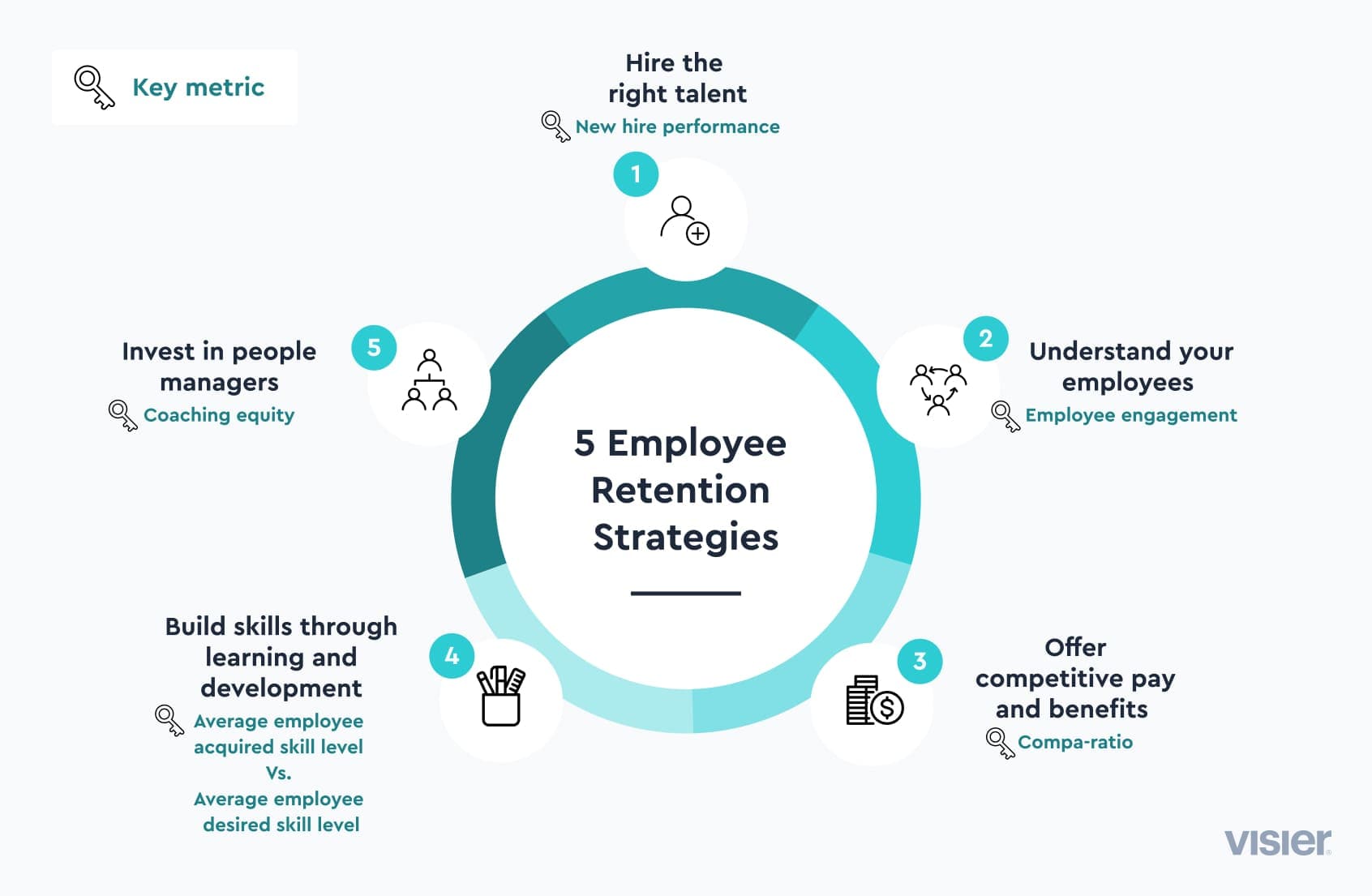HR ANALYTICS
What Is Employee Retention?
Employee retention benefits both employee engagement and customer satisfaction. See where employees are moving and make better decisions to develop a happy, productive workforce.
Get a demoTable of contents
Why is employee retention important to the business?What are the benefits of employee retention?What are five employee retention strategies?Using analytics to improve employee retentionWhy is employee retention important to the business?
Employee retention is a term used to refer to a company’s ability to keep (or retain) its employees.
Companies invest a significant amount of time and effort in recruiting, interviewing, hiring, and onboarding employees. They want to ensure that this investment pays off over time. The longer an employee is with a company, and performing effectively, the greater the payoff.
Losing employees through turnover—voluntary or involuntary—represents lost opportunity and the loss of the investment that the company spent to find that talent in the first place.

3 reasons employee retention is critical to business success
Employee retention ensures the ability to capitalize on talent investments. The longer an employee stays on board, the more value they provide to the organization. The cost of the investment in finding, hiring, onboarding, training, and developing that employee is spread over time.
Employee retention ensures the ability to retain institutional knowledge. As employees tenure with an organization grows, so does their knowledge of the organization and its processes, people, customers, products and services. That institutional knowledge can help to drive creativity and innovation and spark new ideas that the company can leverage to its benefit and the benefit of its customers.
Employee retention helps continually attract new talent as their company becomes known for its strong culture and coveted status as a great place to work.
What is good employee retention?
The measure of good employee retention is often specific to both individual companies, departments, and positions. For instance, call centers will often have a higher rate of turnover than administration. It may be surprising to learn that, according to research from LinkedIn since the pandemic, HR departments actually have the highest level of turnover within most organizations at 14.6%. The rate of turnover in administration was only 7.8%.
According to the Bureau of Labor Statistics (BLS), the median length of time an employee stays with a company is slightly more than four years. That’s not a long time to recoup the investment made in that talent. Average turnover rates in 2021, according to awardco, an employee rewards and recognition platform, were 47.2%. The industry with the highest rate of turnover was construction at 56.9% and the lowest was government at 18%. Generally, according to People Keep, a personalized benefits firm, “employee retention rates of 90% or higher are considered good, meaning a company should aim for an average employee turnover rate of 10% or less.”

What are the benefits of employee retention?
There are a number of benefits related to good employee retention. These include:
Reduced costs. When companies can retain more employees, they can realize cost reductions in talent acquisition. These companies find themselves in the enviable position of having prospective employees continually knocking on their door rather than needing to pound the pavement in search of new talent.
Better productivity. Satisfied and engaged employees are productive employees. Companies with low turnover are in that position because they are able to keep employees satisfied and to engage them with work that they find rewarding and challenging.
Increased morale and satisfaction. Retention goes hand in hand with high morale and satisfaction. It pays for organizations to focus on keeping employees on board by ensuring they have a work experience that they find rewarding and motivating.
The retention of institutional knowledge. Lost employees represent a cost to the organization not only in terms of recruitment and training costs, but also from the institutional knowledge that they gain during their employment—knowledge that they are at risk of taking elsewhere, including to competitors.
What are the risks of poor employee retention?
Some obvious risks of poor employee retention include wasted resources and the added need to continuously recruit new employees.
Another factor that may not be so immediately apparent is the risk of losing customers. High employee turnover is correlated with customer dissatisfaction, which can lead to lost business and related negative word of mouth.
Research conducted at Durham University and published in Management Science Letters found “a strong correlation between customer satisfaction and employee job satisfaction and retention.”
Poor employee retention can also impact the value of the brand both from an employee and a consumer perspective. Employees don’t want to work for a company with a bad employer reputation. Similarly, customers don’t want to do business with these companies because they question the quality and value of their products and services.

What are five employee retention strategies?
It’s apparent that focusing on strategies to improve employee retention is important for companies of all sizes and in all industries. Doing so can help reduce the costs of talent acquisition, retain institutional knowledge and ensure a high level of service to customers.
Retention isn’t an event. It’s a process. And it’s one that requires a commitment from the top of the organization down to the front lines.
Here are five employee retention strategies that represent a strong foundation for building a culture that will help to attract and, most importantly, retain employees.
1. Hire right
If you bring the right employees on board in the first place, you’ll have a better chance of ensuring that those employees stay on board.
What are the “right” employees? They are employees whose personal values are aligned with organizational values, who believe in the organization’s mission and vision, who have the knowledge and ability to do their jobs, and who are committed to continuous improvement and lifelong learning.
2. Understand what matters to employees
Once on board, employees’ needs and interests will likely change over time both as they become familiar with the organization and as the environment—internally and externally—changes over time. Having processes in place to ensure an ongoing means of understanding what matters to employees, and taking actionable steps to provide them what they need, will help ensure that they stay committed to the organization and less likely to look for opportunities elsewhere.
Some tactics to collect this information include regular pulse and longform engagement surveys, townhall Q&As, the collection of feedback at 1:1 meetings, or anonymous questionnaires.
3. Offer competitive pay and benefits
While competitive pay and benefits aren’t the most important thing to employees—research suggests building new skills and learning development opportunities are—they still matter and are often an important point of comparison for employees when considering whether to seek employment elsewhere.
4. Offer learning and development opportunities
Employees value the opportunity to learn and grow. You can provide these opportunities both in the form of traditional training, and through stretch assignments. Not only does this help keep employees engaged and on board, it also benefits your organization as they apply their new skills and talent to help improve your company and its products and services.
As employees learn and grow they are likely to move around the organization. Tracking who goes where can help you identify new opportunities and create an internal mobility program to ensure employees have the opportunities they crave.
5. Train supervisors and managers
Your supervisors and managers need to be good stewards of your employee resources. Retention isn’t something that is “owned” by HR or senior leaders. Yes, they are highly accountable to helping ensure that companies have high levels of retention, but that responsibility spreads throughout the organization—and particularly to supervisors and managers. Those supervisors and managers, though, need to have the skills, information, and resources to help them effectively engage, coach, counsel, and develop the employees they are responsible for.
As companies focus on these broad strategies, they often identify additional retention strategies to help them keep their best talent.These strategies, of course, are highly dependent on the hiring environment companies find themselves in, and are impacted by other external factors (like the pandemic, for instance). Uncertain times call for new, and different, approaches to talent retention.

Using analytics to improve employee retention
Rather than crafting one-size-fits-all retention programs, organizations need to sharpen their focus and apply investment where it will be most impactful—this can vary by department, job function, and employee. To uncover the root causes of turnover, HR organizations and people leaders can adopt an analytical approach to identify flight risk factors and arm business partners with the data to drive action.
With people analytics, you can answer important employee retention questions, such as:
Do your new hires stay on board?
How long do new hires stay at the company?
How much does it cost to replace an employee?
What are key drivers of the resignation rate?
Your diversity, equity, inclusion, and belonging (DEIB) efforts should be integrally tied into your retention efforts. Ensure that you have a data-driven picture of which employees are most at risk for turnover so you can proactively take action to keep them on board.
Understanding the specific retention needs of diverse employees—broken out by sex, age, length of service, racial or ethnic factors, disabilities, etc.—will ensure that you’re not missing key factors that may contribute to rising turnover among key populations.
To keep top talent on board, reducing turnover and protecting your important human resource investments, it's important to use the data and critical insights that will help your company stem the tide of potential turnover, while boosting engagement and productivity.
![6 Signs Your Employee Is About to Resign [CARD ASSET]](https://images.ctfassets.net/lbgy40h4xfb7/1sL4A7XWgw4MFTd4jiZSBs/1d73bd3332da4d34f80fcd87f724b521/resignation-red-flags-resource-card.jpg?w=1200&h=700&fl=progressive&q=100&fm=jpg)

